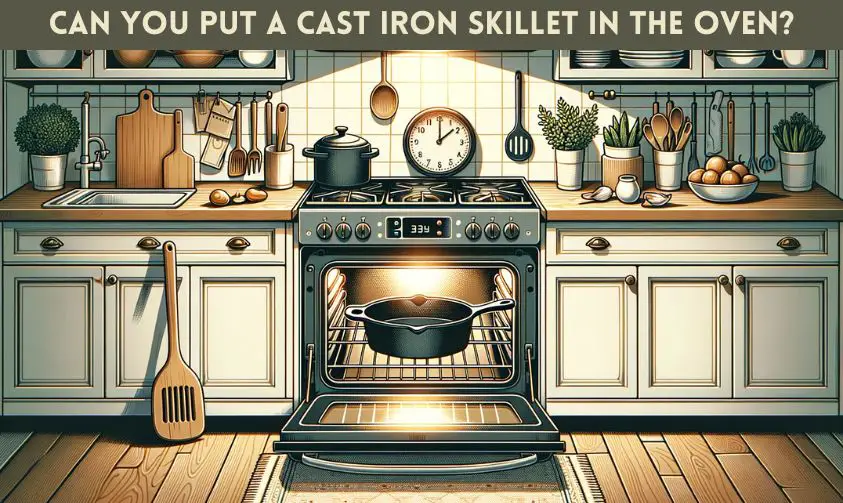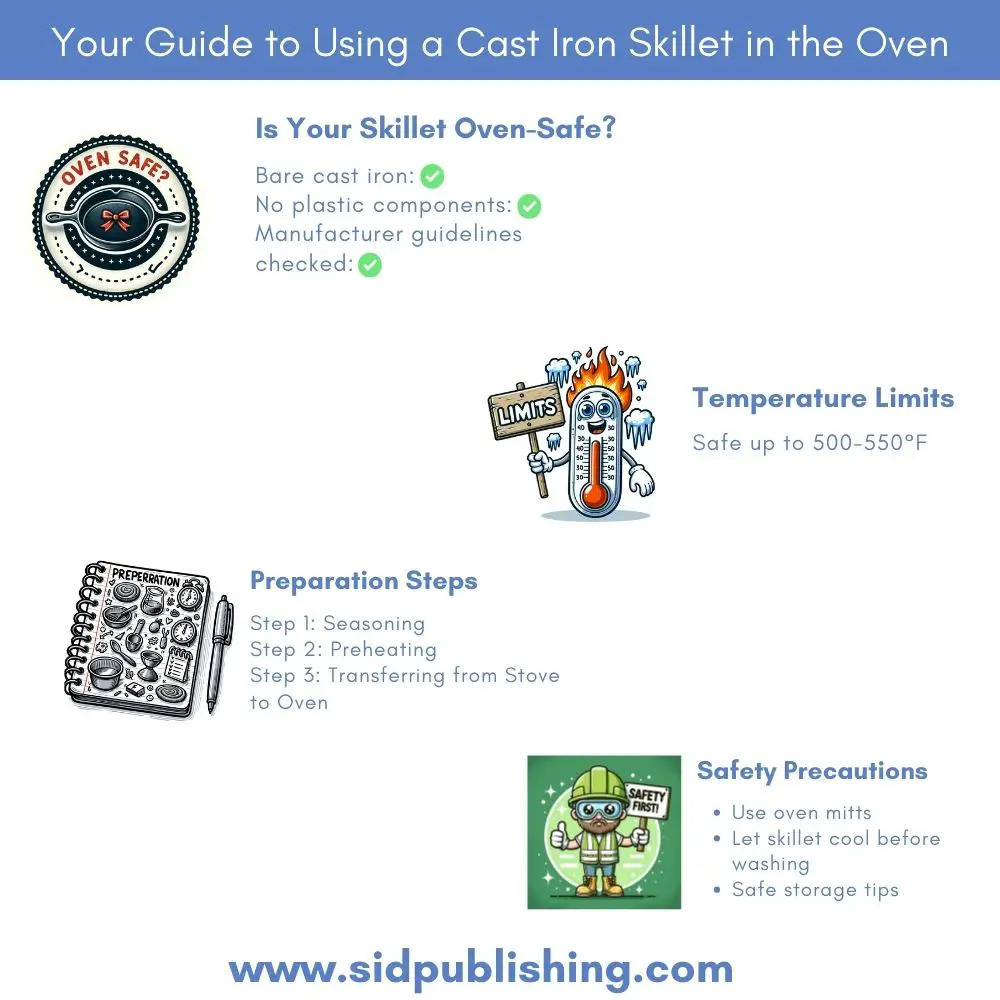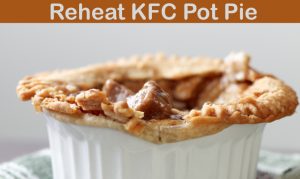You’ve just whipped up some mouth-watering stove-top fajitas, and now you’re wondering if you can toss that cast iron skillet into the oven to keep them warm.
Or maybe you’re looking to try a new skillet cookie recipe but aren’t sure if your trusty cast iron skillet is up for the task. The question looms: Can you put a cast iron skillet in the oven?
Yes, you absolutely can put a cast iron skillet in the oven! But, like with any cooking method, there are some caveats and precautions you should be aware of. So, let’s dig in to ensure you’re doing it safely and effectively.
Understanding whether or not your cast iron skillet can go in the oven is more than just a yes-or-no answer; it’s a query that pops up in various cooking scenarios.
You might be looking to bake bread, make a one-pan dish, or perhaps try your hand at a Dutch baby pancake.
Knowing the ins and outs of oven-safe cookware expands your culinary horizons and ensures you’re cooking safely.

Material Composition of Cast Iron Skillets
Cast iron skillets are made of—you guessed it—cast iron. This type of cookware is well-regarded for its durability, heat retention, and even heat distribution.
One of the many perks of cast iron is its high melting point, which makes it ideal for oven use.
Cast iron is a single, simple material, free of the layers and coatings found in other types of pans. This simplicity makes it incredibly versatile and oven-safe.
Safety Precautions
However, not all cast iron skillets are created equal. If your skillet has a handle made of a different material, like wood or plastic, that component may not be oven-safe.
To know if your cast iron is oven-safe, always read the manufacturer’s guidelines for specific temperature limitations for both the skillet and any additional parts like handles.
Some skillets also come with a coating or enamel finish, which could have its own set of oven-safety guidelines.
Always check these details to ensure you’re not putting something in the oven that isn’t meant to withstand those temperatures.
Pro Tip: A magnet can be a quick way to test the iron content of your skillet. If the magnet sticks, it’s likely your skillet has a high iron content and is oven-safe up to higher temperatures
Safety Precautions for Beginners
Using a cast iron skillet in the oven is generally safe, but taking some extra precautions can ensure a flawless cooking experience. Always use oven mitts to handle the hot skillet and avoid placing a cold skillet in a hot oven to prevent cracking.
Temperature Limitations
When using your cast iron skillet in the oven, it’s crucial to know its temperature limitations. Generally speaking, a bare, uncoated cast iron skillet can withstand temperatures up to 500°F to 550°F without any issues.
Did You Know?
Cast iron cookware has stood the test of time, with its usage dating back to the Han Dynasty in China over two millennia ago. The metallurgical properties of cast iron, such as its high melting point and excellent heat retention, make it capable of withstanding high oven temperatures. This is why cast iron has been a cookware material of choice for generations.
However, if your skillet has an enamel coating or if the handle is made of a material other than cast iron, you’ll want to consult the manufacturer’s guidelines for specific temperature restrictions.
Common Myths About Using Cast Iron in the Oven
t’s amazing how certain myths can make people wary of using cast iron in the oven. Let’s bust some of these myths wide open so you can cook with confidence.
- Myth: Cast iron skillets are prone to rusting in the oven.
Truth: With proper seasoning and care, your cast iron skillet can stay rust-free, even when used in the oven. - Myth: Food will stick to the skillet in the oven.
Truth: A well-seasoned cast iron skillet provides a fairly non-stick surface, making it ideal for oven use.
How Long Do You Put a Cast Iron Skillet in the Oven?
The duration you keep a cast iron skillet in the oven can vary widely depending on the specific recipe you’re following. However, to give you a general idea:
- For baked goods like cornbread or skillet cookies, you’ll typically need about 20 to 25 minutes at around 375°F to 425°F.
- For meat dishes like a roast or chicken, expect to cook for at least 30 to 45 minutes at temperatures ranging from 375°F to 450°F.
- For casseroles or one-pan meals, the cooking time can range from 25 to 35 minutes at temperatures around 350°F to 400°F.
Here’s a handy table for reference:
| Type of Dish | Oven Temperature | Approximate Time |
|---|---|---|
| Baked Goods | 375°F – 425°F | 20 – 25 minutes |
| Meat (Roast, Chicken) | 375°F – 450°F | 30 – 45 minutes |
| Casseroles | 350°F – 400°F | 25 – 35 minutes |
| Vegetables | 400°F – 450°F | 15 – 25 minutes |
| Seafood | 375°F – 425°F | 12 – 20 minutes |
It’s important to consult your recipe for precise cooking times, but these general guidelines should give you a good starting point for a variety of dishes.
Pre-Seasoning Before Oven Use
Before popping that skillet into the oven, it’s a good idea to make sure it’s well-seasoned. Seasoning your cast iron skillet involves coating it with a layer of oil and heating it until the oil polymerizes, forming a natural non-stick surface.
This not only makes your food taste better but also protects your skillet from rust and other forms of wear and tear. A well-seasoned skillet will perform better in the oven, ensuring that your food cooks evenly and that cleanup is a breeze.
Benefits of Oven Use
So why bother using a cast iron skillet in the oven in the first place? Well, there are several advantages:
- Even Heat Distribution: Cast iron is excellent at retaining heat and distributing it evenly, reducing the chances of hot spots that can ruin your dish.
- Versatility: With a cast iron skillet, you can start your dish on the stovetop and then move it to the oven to finish cooking, all without changing pans.
- Flavor: Cast iron can enhance the flavor of your food, especially as the skillet becomes more seasoned over time.
What are the alternatives to Cast Iron for Oven Use?
If you’re looking for alternatives to a cast iron skillet for oven use, you have several options to consider. Each comes with its own set of advantages and disadvantages, but they offer flexibility based on your specific cooking needs. Here’s a rundown of some popular alternatives:
Stainless Steel
Pros: Stainless steel pans are versatile, lightweight, and generally dishwasher safe. They can also withstand high temperatures without releasing toxic fumes. Cons: They don’t retain heat as well as cast iron, and they can be more prone to sticking if not properly greased.
Ceramic-Coated Cookware
Pros: Ceramic-coated pans are non-stick and easier to clean than cast iron. They are also lighter in weight. Cons: They can’t withstand the same high temperatures as cast iron, usually maxing out around 450°F. The coating may also deteriorate over time.
Glass Bakeware
Pros: Glass is non-reactive, meaning it won’t interact with acidic or alkaline foods. It’s also microwave safe. Cons: Glass is not ideal for stove-to-oven use and can break if exposed to rapid temperature changes.
Hard-Anodized Aluminum
Pros: Hard-anodized aluminum is durable and more non-stick than stainless steel. It also heats up quickly. Cons: Like ceramic, it usually has a temperature limit, often around 500°F. It’s also not suitable for cooking acidic foods.
Enamel-Coated Cast Iron
Pros: Enamel-coated cast iron offers much of the same heat retention as regular cast iron but doesn’t require seasoning. Cons: These are generally heavy and can chip or crack if dropped. They are also often more expensive than bare cast iron.
Conclusion
In summary, yes, you can—and should—put your cast iron skillet in the oven. Just be mindful of any special features like different handle materials or coatings that could affect its oven-safety. Always remember to check the manufacturer’s guidelines and ensure your skillet is well-seasoned before oven use.

Frequently Asked Questions
Is seasoning necessary before oven use?
Seasoning your cast iron skillet before using it in the oven is not just a good practice, it’s essential. The seasoning process involves coating the skillet with a thin layer of oil and heating it to create a natural, non-stick surface. This not only makes your cooking experience more enjoyable by preventing food from sticking, but it also acts as a barrier against moisture, reducing the risk of rust. So, before you pop that skillet into the oven, make sure it’s well-seasoned to get the best results and prolong its lifespan.
Can I put a cast iron lid in the oven?
Most cast iron lids are designed to be oven-safe, just like their skillet counterparts. However, it’s crucial to check the manufacturer’s guidelines to confirm that your specific lid is built to withstand the oven temperatures you intend to use. If your cast iron lid has a knob or handle made of a material other than cast iron, like wood or plastic, you’ll need to be extra cautious as those materials may not be oven-safe. Always read the product information to ensure you’re using your cast iron lid safely and effectively in the oven.
Do I need to preheat my cast iron skillet before putting it in the oven?
Preheating your cast iron skillet can be beneficial, especially for recipes that require a hot surface right from the start, like cornbread or certain types of meat.
Is it safe to move a cast iron skillet from stove to oven?
Yes, one of the advantages of a cast iron skillet is its versatility; it can go from stovetop to oven safely. Just be cautious when handling it, as it will be extremely hot.
How do I clean my cast iron skillet after using it in the oven?
Cleaning should be done while the skillet is still warm. Use hot water and a brush or sponge to remove food particles. Avoid using soap or putting it in the dishwasher, as this can strip away the seasoning.
Should I use a different oil for seasoning when using the skillet in the oven?
Most oils will work for seasoning, but those with a high smoke point like canola or grapeseed oil are often recommended. The type of oil you use for seasoning shouldn’t be affected by whether the skillet will be used in the oven or on the stove.
Is it okay to store my cast iron skillet in the oven?
While some people do store their cast iron skillets in the oven, remember to remove it before preheating the oven for another recipe. Also, ensure the skillet is completely dry to prevent rust.


